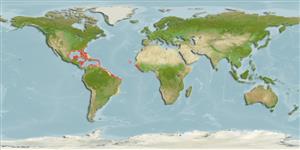Common names from other countries
Classification / Names / Names
आम नाम | उपशब्द | Catalog of Fishes (gen., sp.) | ITIS | CoL | WoRMS
Environment: milieu / climate zone / depth range / distribution range
पारिस्थितिकी
; गहराई सीमा 0 - 90 m (Ref. 441). Tropical, preferred 27°C (Ref. 107945); 35°N - 24°S, 97°W - 11°E (Ref. 4)
Atlantic Ocean.
Length at first maturity / आकार / वज़न / Age
Maturity: Lm 8.3, range 7 - 8.1 cm Max length : 45.0 cm TL पुल्लिंग / अलिंग; (Ref. 4); common length : 20.0 cm TL पुल्लिंग / अलिंग; (Ref. 4); अधिकतम सूचित उम्र: 15 वर्षो (Ref. 129472)
Longevity from Ref. 129472 (Supplementary material). Occurs at depths down to 90 m, perhaps even deeper; usually inhabits shallow waters and found among rocks, on reefs, eelgrass beds or in any habitat that provides protection. The species is gregarious and migratory. Females move to deeper water for spawning and there are mass migrations in the autumn when the animals, in single files up to 50 individuals, move in a certain direction in daytime, each animal having body contact with the next through the antennae; In the northern part of its range, larvae are found mainly from June to December (Ref. 4).
Life cycle and mating behavior
परिपक्व अवधि | पुनरुत्पत्ति | मछलीऔ का अंडे देना | अंडे | Fecundity | लार्वा
Females move to deeper water for spawning and there are mass migrations in the autumn when the animals, in single files up to 50 individuals, move in a certain direction in daytime, each animal having body contact with the next through the antennae; In the northern part of its range, larvae are found mainly from June to December (Ref. 4).
Holthuis, L.B. 1991. (Ref. 4)
IUCN Red List Status (Ref. 130435)
CITES status (Ref. 108899)
Not Evaluated
Not Evaluated
Human uses
मात्स्यिकी: व्यापारिक
FAO - मात्स्यिकी: landings, species profile | FIRMS (Stock assessments) | FishSource | Sea Around Us
साधन
इंटरनेट स्रोत
Estimates based on models
Preferred temperature
(Ref.
115969): 23.7 - 28, mean 26.7 (based on 346 cells).
लौटाव
माध्यम, न्यूनतम जनसंख्या दुगनी होने का समय 1.4 - 4.4 वर्ष। (K=0.16-0.39; tm=4).
Prior r = 0.82, 95% CL = 0.54 - 1.23, Based on 1 full stock assessment.
Vulnerability
Low to moderate vulnerability (35 of 100).
